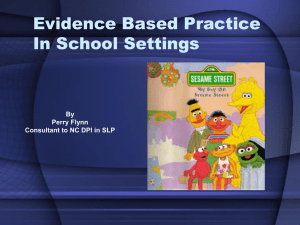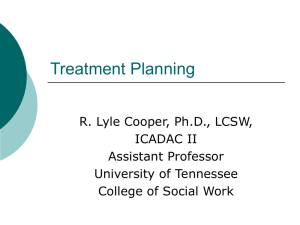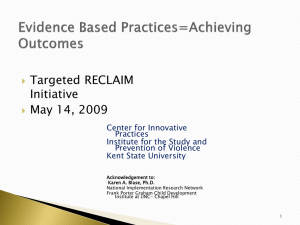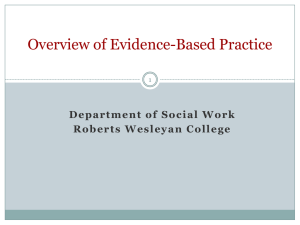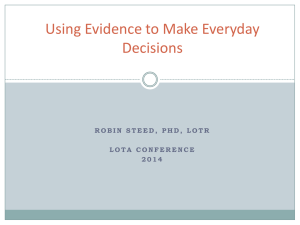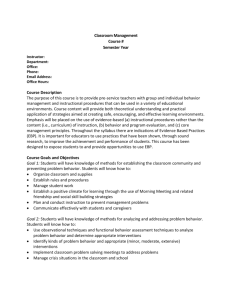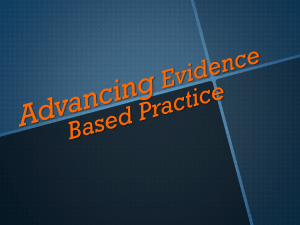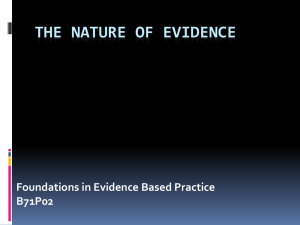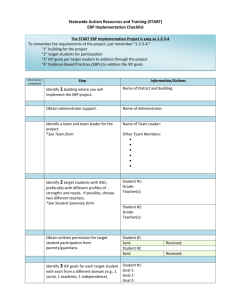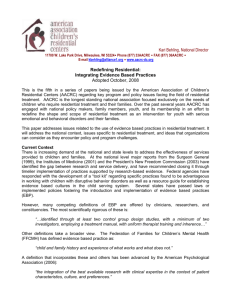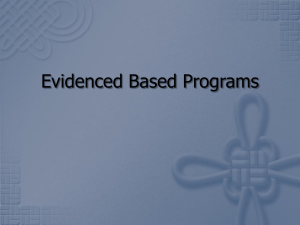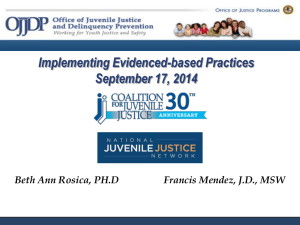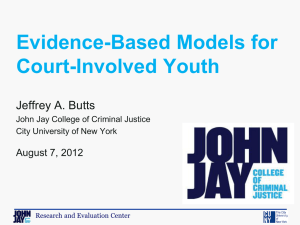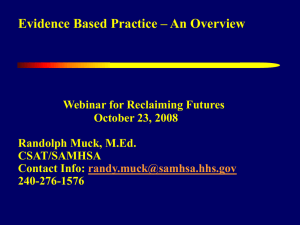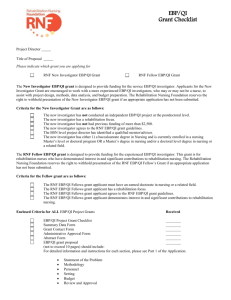MH Evidence Based Practice PowerPoint
advertisement
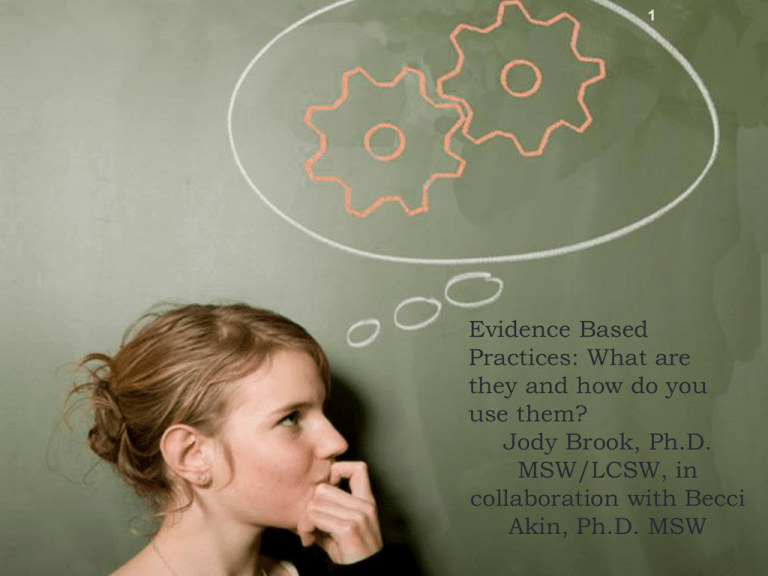
1 EVIDENCE BASED PRACTICE Evidence Based Practices: What are they and how do you use them? Jody Brook, Ph.D. MSW/LCSW, in collaboration with Becci Akin, Ph.D. MSW 2 What is Evidence Based Practice (EBP)? (Based on IOM, 2001 definition, with modifications and additions by author) Best Available Evidence Client Characteristics, needs, values, preferences, and culture. Evidence Based Practice Organizational Environment and Resources Clinical Wisdom 3 What’s up with the name game of: • Evidence Based Practice • Evidence Informed Practice • Best Practices • Evidence Informed Intervention • Empirically Supported Treatment And the incredibly important and distinct concept of : Practice Based Evidence 4 How do you find a “real” EBP? • Depends on who you ask! • Generally speaking: o Rigorous evaluation shows positive results o The results can be linked to the program intervention o Subject to peer review and independent scrutiny by independent experts o Designation by a federal agency, or respected review organization in the field o Buyer beware-EBP can be a marketing buzzword! 5 Why do we need EBP? • Commitment to clients and their needs; • We all have limited resources, so using them with something that • • • • works is better use of resources; Most EBP’s are fully developed (may need to modify); Accountability to funders/stakeholders; Existing evaluation resources for effectiveness and cost/benefit analyses; One stop shop for training, manualized curriculums, support, etc… 6 Preparing for Evidence Based Practice……..Ready, or Not? 7 Assessing agency readiness • What is the driving force behind the desire to implement change? • Is your staff open to this? • How does this fit with structure and day to day activities? • What can you learn from past experience with implementing new practices? • How does this fit with other stakeholders and collaborative agencies in the community? • Bottom line: Implementing EBP’s requires organizational planning. 8 What is the problem you are seeking to address and with what population? • These are critical questions answer before selecting an • • • • • • EBP. Understand your consumer and context Review factors to consider (handout) It must be evidence based for the population you intend to serve; It must work on a clinical and practical level; It must ultimately be something that is sustainable if it works. You will not find a ‘perfect’ fit-so how can you adjust and work with what is there? 9 Considerations: • Understand needs of your consumers - what do these individuals and/or families look like? Are there unique struggles? • Have realistic expectations of their ability to participate. • What are the needs of the community? What are the strengths and weaknesses? • What are the challenges you believe you will face and how can you plan to address them? • The difference between availability of services and true access to services 10 Factors to consider: • Describe the problem • Describe the co-occurring conditions Outcome (what you want to happen) Client: Agency Service: Community: 11 Client, Agency and Community Factors to Consider Before and During EBP Selection Target population demographics and characteristics-age, gender, race/ethnicity, household structure, reason for seeking service. Disability, physical or other needs Cultural, linguistic, or other adaptations needed Setting constraints Training and logistical capabilities Strengths and natural resources of population Agency support (all levels) Sustainability 12 Accessing EBP Information • Most commonly used registries in mental health: • http://www.nrepp.samhsa.gov/. • http://www.cebc4cw.org/. • http://www.campbellcollaboration.org/resources/links/links _social_welfare.php. • http://www.cochrane.org/. 13 Assessing the fit of an EBP to your organization: • Levels of Evidenceo Evidence-Based Practice Rating Scale o 1 = Well-Supported by Research Evidence o 2 = Supported by Research Evidence o 3 = Promising Research Evidence o 4 = Emerging Practice Quality of Research Readiness for Dissemination Reviewer Selection and Training • Non-Researcher’s Guide to EBP Evaluation http://www.nrepp.samhsa.gov/Courses/ProgramEvaluation/NREPP_0401 _0010.html. 14 Sample structure for EBP Assessment 15 Evaluating the credibility of sources of information: (Based on Krysik and Finn, 2010) • Authority • Intent & proprietary interest • Currency • Fairness • Reliability Assessing Evidence-Based Programs and Practices Capacity to Implement Staff meet minimum qualifications Able to sustain Imp Drivers • Financially • Structurally • Buy-in process operationalized • Practitioners • Families • Agency Intervention Readiness for Replication Qualified purveyor Expert or TA available Mature sites to observe # of replications How well is it operationalized? Are Imp Drivers operationalized? EBP: Need in Agency, Setting Socially Significant Issues Parent & Community Perceptions of Need Data indicating Need Fit with current •Initiatives • State and Local Priorities • Organizational structures • Community Values Need Capacity to Implement Fit Intervention Readiness for Replication Resource Availability Evidence Resource Availability IT Staffing Training Data Systems Coaching & Supervision Administrative & system supports needed 5 Point Rating Scale: High = 5; Medium = 3; Low = 1. Midpoints can be used and scored as a 2 or 4. High Medium Need Fit Resources Availability Evidence Low Evidence Outcomes – Is it worth it? Fidelity data Cost – effectiveness data Number of studies Population similarities Diverse cultural groups Efficacy or Effectiveness Readiness for Replication Capacity to Implement Total Score: © National Implementation Research Network 2009 Adapted from work by Laurel J. Kiser, Michelle Zabel, Albert A. Zachik, and Joan Smith at the University of Maryland 17 Critical Steps in Quality Implementation (Reference: Meyers, D. C., Durlak, J. A., & Wandersman, A. (2012). The Quality Implementation Framework: A Synthesis of Critical Steps in the Implementation Process). Initial Considerations Creating a Structure for Implementation Ongoing structure once EBP is implemented Improving future applications 18 Common concerns about EBP implementation: • Costs • Status quo • Different values and beliefs • Limits practitioner flexibility • We (or our clients) are too different! 19 Selecting the right EBP is a victory!
